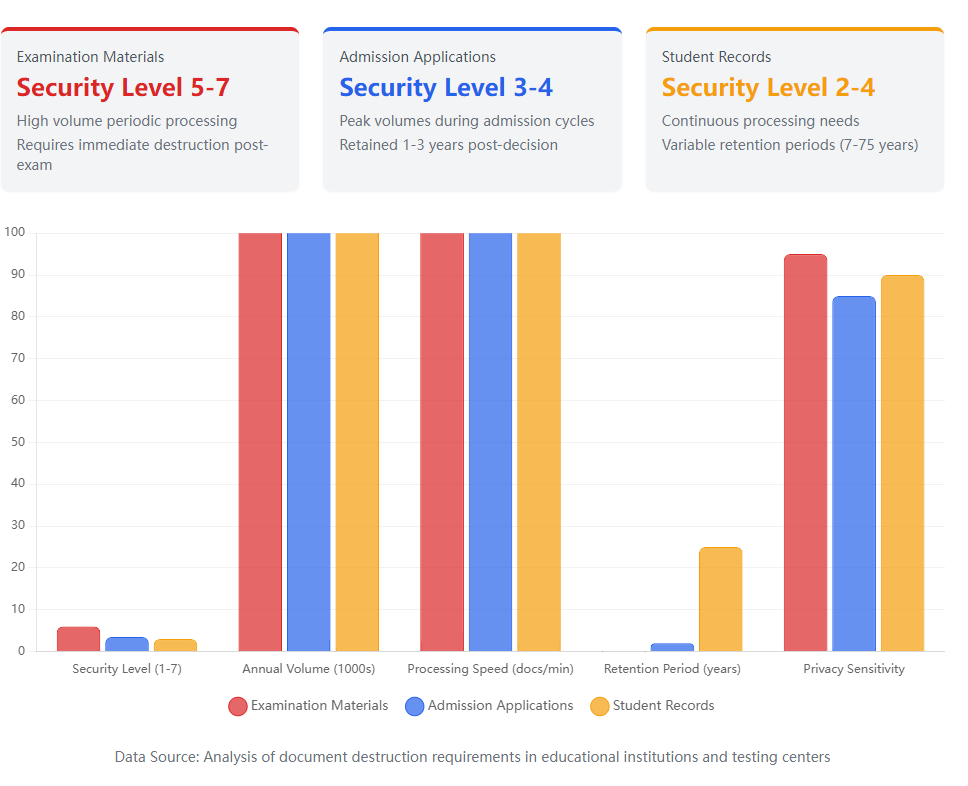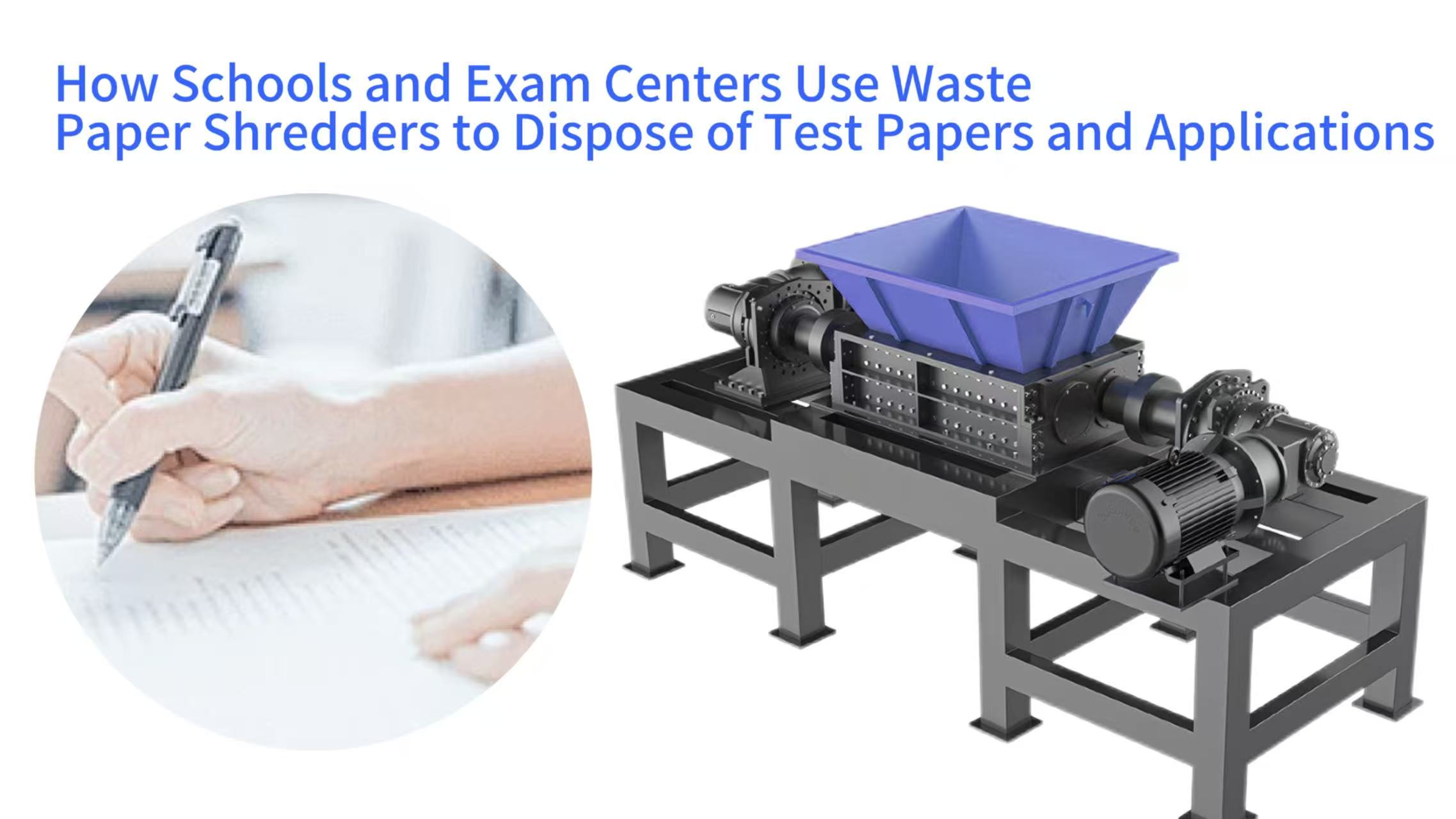Educational institutions manage substantial volumes of sensitive information ranging from high-stakes examination materials to personally identifiable student records. This examination explores how schools and testing centers implement industrial-grade shredding solutions to address large-scale security challenges while maintaining compliance with data protection regulations. The systematic approach to document destruction ensures educational integrity while protecting stakeholder privacy throughout the information lifecycle.
Unique Information Security Challenges in Educational Institutions
Educational organizations face distinctive security pressures characterized by predictable peak demand periods and profound consequences from information breaches. The protection of assessment materials extends beyond simple data privacy to encompass the fundamental credibility of educational evaluation systems. These institutions must balance accessibility with security across diverse environments including classrooms, administrative offices, and examination halls. The cyclical nature of academic calendars creates concentrated periods of vulnerability requiring robust security protocols.
Security Lifecycle Management for High-Stakes Testing Materials
Examination documents remain vulnerable throughout their entire existence from creation and printing to distribution, administration, and final disposition. Each phase presents distinct security challenges requiring specific protective measures and accountability protocols. The destruction phase represents the irreversible conclusion of the security chain, eliminating any possibility of future compromise or unauthorized access. Proper destruction validates the integrity of preceding security measures while ensuring no residual risk remains from discarded materials.
Privacy Protection Obligations for Student Applications and Records
Educational institutions process thousands of admission applications, academic transcripts, and permanent records containing protected personal information under various privacy regulations. These documents typically include social security numbers, financial information, academic performance data, and personal statements requiring secure handling. Legal frameworks like FERPA in the United States mandate specific protection standards for student records, with destruction requirements based on document type and retention periods. The volume and sensitivity of these materials necessitate systematic destruction approaches that prevent reconstruction or recovery.
Addressing Internal and External Information Security Threats
Educational environments face dual threats from both internal actors including staff and students and external entities seeking unauthorized access to sensitive information. Physical destruction provides definitive protection against both threat categories by eliminating the information entirely. Internal threats may involve intentional misconduct or inadvertent security lapses, while external threats range from sophisticated cyber attacks to physical theft of documents. Industrial shredding technology offers protection independent of digital security measures, creating an additional layer of security for physical materials.
Industrial Shredders as the Preferred Solution for Educational Institutions
Conventional office shredders prove inadequate for the volume and security requirements of educational document destruction, making industrial-grade systems the logical choice for institutional applications. These robust machines deliver superior processing capacity, enhanced security levels, and lower per-document destruction costs compared to decentralized office equipment. The operational reliability of industrial systems ensures consistent performance during critical destruction periods following examination sessions or admission cycles. Educational institutions benefit from the automated features and integrated security controls available in modern industrial shredding equipment.
Peak Processing Capacity Advantages During Critical Periods
Following examination periods or admission cycles, institutions must destroy massive document quantities within compressed timeframes to minimize security risks. Industrial shredders maintain continuous operation under heavy loads, processing several tons of materials per day without performance degradation. This capacity enables centralized destruction operations that consolidate materials from multiple locations for efficient processing. The alternative of distributed destruction using office equipment creates logistical challenges and inconsistent security outcomes across large institutions.
Security Standards and Compliance Verification Capabilities
Industrial cross-cut and micro-cut shredders readily achieve particle size requirements specified in data protection regulations and security standards. These systems produce fragments measuring 2x15 millimeters or smaller for cross-cut models and sub-millimeter particles for micro-cut configurations, exceeding typical office shredder security levels. The destruction process generates auditable evidence including particle samples and processing logs that demonstrate compliance during institutional reviews or accreditation processes. This verification capability proves particularly valuable for institutions subject to external oversight or quality assurance requirements.
Material Diversity Handling From Paper to Composite Items
Industrial shredders process laminated test documents, bound answer booklets, plastic cover sheets, and accompanying stationery through integrated destruction workflows. This comprehensive approach eliminates the need for manual separation of different material types, streamlining operations and reducing handling risks. Advanced systems incorporate specialized cutting geometries and power management to maintain performance across varying material characteristics without adjustment or reconfiguration. The ability to process mixed materials ensures complete destruction of all examination components in a single operational sequence.
Standardized Test Paper Disposal: Closed-Loop Security Process
Examination document destruction represents the highest security application within educational environments, requiring meticulously controlled procedures from collection through final disposition. Each process phase occurs under documented supervision with multiple verification points ensuring accountability and compliance. The systematic approach transforms sensitive examination materials into anonymous fragments suitable for recycling or secure disposal. This transformation occurs through precisely engineered mechanical processes that eliminate any possibility of information recovery.
Secure Collection, Transportation and Temporary Storage Protocols
Used examination materials transfer directly from testing venues to designated destruction areas under continuous monitoring and chain-of-custody documentation. Temporary storage facilities incorporate access controls, environmental protection, and inventory management systems that prevent unauthorized contact with materials awaiting destruction. Security personnel maintain presence during storage periods, with surveillance systems providing additional monitoring and recording capabilities. These measures ensure materials remain protected throughout the interim period between examination completion and scheduled destruction.
Standardized Destruction Procedures and Multi-Person Oversight
Destruction operations require at least two authorized personnel present throughout processing, providing mutual supervision and verification of proper procedure execution. Operators follow documented workflows that feed materials directly into industrial shredders without intermediate sorting, handling, or storage steps that might create security vulnerabilities. The process incorporates equipment performance monitoring and periodic quality verification to ensure consistent particle size and complete destruction. Documentation includes timestamps, material quantities, and participant identification for permanent record keeping.
Destruction Evidence Retention and Traceability Management
Each destruction event generates representative particle samples preserved in sealed containers with identifying information including date, batch designation, and responsible personnel. These samples provide physical evidence of destruction completeness and particle size compliance should questions arise regarding process integrity. The documentation system enables precise tracing of specific material batches through destruction, confirming execution according to established schedules and protocols. This evidence retention practice demonstrates institutional diligence and provides defensible documentation of regulatory compliance.
Admissions Application Processing: Volume Destruction Operations
Admissions offices accumulate substantial volumes of applicant materials requiring secure destruction following decision cycles and legal retention periods. These documents contain extensive personal information requiring protection under privacy regulations and institutional policies. The concentrated nature of admission cycles creates efficiency opportunities through batch processing and automated handling systems. Proper destruction safeguards institutional reputation while fulfilling legal obligations regarding personal information management.
Sensitive Information Types in Application Materials
Admission applications constitute comprehensive personal dossiers containing academic records, standardized test scores, financial information, personal statements, and recommendation letters. These materials frequently include government identification numbers, contact information, and other data elements attractive to identity thieves. The compromise of application materials creates significant liability exposure through potential identity theft, privacy violations, and reputational damage. The sensitivity and volume of these documents necessitate industrial-scale destruction capabilities with verified security outcomes.
Efficient Preprocessing and Automated Feeding System Integration
High-volume destruction operations incorporate preprocessing equipment including envelope openers, staple removers, and document flatteners that prepare materials for efficient shredding. Industrial shredders integrate with conveyor systems and automated feeders that maintain continuous material flow while minimizing manual handling requirements. These integrated systems process thousands of application documents per hour while maintaining consistent security levels and operational efficiency. The automated approach reduces labor requirements while improving throughput predictability and destruction consistency.
Security and Sustainability Balance in Material Disposition
Cross-cut shredding configurations produce particles that balance security requirements with recyclability, enabling institutions to demonstrate environmental responsibility alongside security diligence. The paper fragments generated through industrial shredding serve as valuable feedstock for recycling operations, completing the material lifecycle in an environmentally responsible manner. Institutions frequently partner with certified recycling providers that process shredded materials into new paper products, creating a circular economy around document destruction operations. This approach aligns with sustainability initiatives increasingly important to educational communities and stakeholders.
Student Record and Administrative Document Management
Educational institutions maintain extensive archives of student records, administrative documents, and operational materials subject to retention schedules and eventual destruction requirements. These materials transition from active reference to secure destruction according to established policies based on regulatory requirements and institutional needs. The systematic management of document lifecycles ensures proper retention while preventing indefinite accumulation of sensitive materials. Industrial shredding provides the capacity and security necessary for periodic destruction events involving archived materials.
Data Retention Policy Compliance and Destruction Scheduling
Institutions establish comprehensive retention policies based on legal requirements, operational needs, and risk management considerations, defining specific timeframes for various document categories. These policies generate scheduled destruction events that systematically remove obsolete materials from institutional custody according to predetermined timelines. Automated tracking systems monitor retention periods and generate destruction work orders when materials reach their designated endpoints. This systematic approach prevents premature destruction of potentially valuable records while eliminating indefinite retention security risks.
Bound Volume and Mixed Media Material Processing Challenges
Archival materials frequently exist as bound volumes, fastened documents, or mixed-media collections containing photographs, optical media, and paper components. Industrial shredders process these complex material configurations without disassembly through powerful cutting mechanisms and integrated separation systems. The robust construction and high-torque drives of industrial equipment maintain performance when encountering reinforced bindings, fasteners, and non-paper components within document collections. This capability ensures complete destruction of archival materials regardless of format or composition while maintaining operational efficiency.
Developing Economical and Compliant Destruction Systems for Education
Implementing institutional destruction capabilities requires comprehensive planning encompassing equipment selection, facility preparation, staffing, and ongoing operational management. The investment analysis must consider total cost of ownership rather than simply acquisition expense, incorporating operational, maintenance, and compliance factors. Educational institutions typically evaluate multiple implementation models including equipment ownership, service contracts, and hybrid approaches based on specific operational patterns and resource availability. The selected approach must align with institutional risk tolerance, budgetary constraints, and operational capabilities.

Procurement Decisions: Equipment Ownership Versus Service Contracts
Institutions determine whether to purchase shredding equipment for internal operation, contract with specialized destruction services, or implement hybrid solutions combining both approaches. Equipment ownership proves cost-effective for institutions with consistent destruction volumes and available technical staff to operate and maintain the systems. Service contracts provide specialized expertise and capacity flexibility for institutions with fluctuating volumes or limited internal resources. Mobile shredding services offer intermediate solutions with on-site destruction using specialized vehicles that process materials at institutional locations.
Internal Destruction Team Development and Responsibility Assignment
Institutions operating internal destruction capabilities develop specialized teams with appropriate security clearance, technical training, and procedural knowledge. Team structures typically separate material handling, equipment operation, supervision, and auditing functions to establish checks and balances within the destruction process. Training programs encompass equipment operation, maintenance procedures, security protocols, and emergency response measures relevant to destruction operations. Background verification and ongoing evaluation ensure team members maintain the trustworthiness required for handling sensitive materials throughout the destruction lifecycle.
Emergency Response Planning for Security Incident Management
Institutions develop specific protocols for emergency destruction scenarios involving potentially compromised materials or security breaches requiring immediate response. These plans define authorization processes, mobilization procedures, and execution methods for rapid destruction of materials under emergency conditions. The plans incorporate communication protocols, documentation requirements, and post-incident assessment procedures that validate response effectiveness and identify improvement opportunities. Emergency destruction capabilities provide critical risk mitigation when standard destruction schedules prove inadequate to address immediate security threats. The implementation of these comprehensive destruction systems enables educational institutions to meet their security obligations while demonstrating responsibility in handling sensitive information. The industrial paper shredding systems employed by these organizations represent the convergence of security, efficiency, and compliance in protecting educational integrity and stakeholder privacy.
